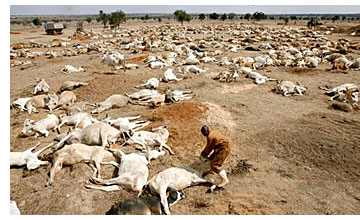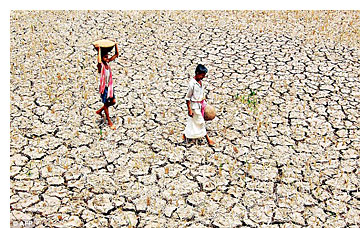 |
|
About Mission 2019:
Final presentation for 12.000 Solving Complex Problems (Fall 2015) Be sure to see the student web site, Food Security in the Face of a Changing Climate. At least a billion of the seven billion people on earth are chronically malnourished. World population is expected to hit 9 billion by the middle of this century, with the highest growth rates in regions with the greatest food insecurity. Rising per capita wealth, while an important development goal, continues to increase demand faster than population growth, with many researchers predicting that we will need to increase food supply by 70-100% by 2050. This increasing demand puts more pressure on arable land, as well as depleting clean water and energy resources in a world where 30-40% of land is already used for agriculture. 
Because enhanced agriculture means greater environmental impact – including increased energy use, greenhouse gas production, reliance on pest management, nutrient run-off, biodiversity loss from land conversion and monocultures, soil loss, and overall water usage – we must utilize advanced cropping techniques, and possibly even an entirely new approach to agriculture, in order to mitigate those impacts. Special care will need to be taken, because in some cases during attempts to ameliorate these problems, large-scale, well-funded, state-of-the art and ultra-efficient, corporate farming enterprises – built with foreign investment in developing countries – might trample the rights of the native peoples. With a world population of 9 billion expected by 2050 – and a billion people currently malnourished – we simply cannot continue with business as usual. An integrated cost-effective global strategy is needed to ensure sustainable and equitable food security. This must include a major re-thinking of agricultural practices as well as modifying the diets of much of the world's population. To learn more about this topic, check out this reading list. Mission 2019 is also part of the Terrascope program and the issues associated with feeding the world's population will be a year long theme of Terrascope. By enrolling in 12.000 you become part of the Terrascope program and community, even if you do not continue in the Spring. Spring Field Trip: During spring break in March of 2016 we will take a field trip to some part of the world where we can see first hand issues associated with food security in theory and practice. About 12.000: "Solving Complex Problems" (12.000) is a nine-unit, Fall-semester subject designed to provide freshmen with the opportunity to work as part of an "imagineering" team to design a viable solution to a complex problem that requires an interdisciplinary approach. The subject is also known as Mission 2019, Food security in the face of a changing climate. Students present their final design before a panel of experts and develop a website to provide a detailed description of their plan.  Each year's class explores a different problem in detail through the study of
complimentary case histories and the development of creative solution strategies.
It includes training in web site development, effective written and oral communication,
and team building. Initially developed with major financial support from the Alex
and Britt
d'Arbeloff Fund for Excellence in MIT Education, 12.000 is designed to enhance
the freshman experience by helping students develop contexts for other subjects
in the sciences and humanities, and by helping them to establish learning communities
that include upperclassmen, faculty, MIT alumni, and professionals in science
and engineering fields. Each year's class explores a different problem in detail through the study of
complimentary case histories and the development of creative solution strategies.
It includes training in web site development, effective written and oral communication,
and team building. Initially developed with major financial support from the Alex
and Britt
d'Arbeloff Fund for Excellence in MIT Education, 12.000 is designed to enhance
the freshman experience by helping students develop contexts for other subjects
in the sciences and humanities, and by helping them to establish learning communities
that include upperclassmen, faculty, MIT alumni, and professionals in science
and engineering fields. Why Mission? The Mission class offer freshman a completely different way to learn. In contrast to the core classes that rely on lectures and problem sets, Mission attempts to teach students how to think about solving complex problems. Students in Mission are independent, largely self-directed, and interactive. They learn how to build teams and develop solutions that require teamwork between scientists and engineers. Mission students will learn that many problems are just too big and complex to be solved by any one person or discipline and must involve integration. At the end of the class the students of Mission will have developed new and innovative solutions to an "unsolvable" problem and been exposed to a variety of different disciplines. History of the Class  Mission, or 12.000, was offered first in Fall 2000, when the assignment (Mission
2004) was to develop a viable mission plan for the exploration of Mars with
the aim of finding evidence for the present or past existence of life. The assignment
for Fall 2001 (Mission
2005) was to design undersea research stations for both
coral reef and abyssal environments. Fall of 2002 (Mission
2006) charged students
with developing a strategy for monitoring and preserving the Amazon Rainforest.
As in previous years, the students in Mission 2006 described their final design
in a content-rich web site and an oral presentation in front of a panel of international
experts. Mission
2007 was focused on Arctic National Wildlife Refuge (ANWR),
Mission
2008,
Galapagos; Mission
2009, Tsunamis; and Mission
2010, Saving N'awlinz; Mission
2011, Saving our oceans; Mission 2012, Clean water-assuring clean fresh water for western North America; Mission 2013, CO2 sequestration; and Mission 2014, Feeding the World; Mission 2015, Whole Earth Triage - Securing the future of biodiversity; Mission 2016, The Future of Strategic Resources; Mission 2017, Water Security; and Mission 2018, developing an energy portfolio. Mission, or 12.000, was offered first in Fall 2000, when the assignment (Mission
2004) was to develop a viable mission plan for the exploration of Mars with
the aim of finding evidence for the present or past existence of life. The assignment
for Fall 2001 (Mission
2005) was to design undersea research stations for both
coral reef and abyssal environments. Fall of 2002 (Mission
2006) charged students
with developing a strategy for monitoring and preserving the Amazon Rainforest.
As in previous years, the students in Mission 2006 described their final design
in a content-rich web site and an oral presentation in front of a panel of international
experts. Mission
2007 was focused on Arctic National Wildlife Refuge (ANWR),
Mission
2008,
Galapagos; Mission
2009, Tsunamis; and Mission
2010, Saving N'awlinz; Mission
2011, Saving our oceans; Mission 2012, Clean water-assuring clean fresh water for western North America; Mission 2013, CO2 sequestration; and Mission 2014, Feeding the World; Mission 2015, Whole Earth Triage - Securing the future of biodiversity; Mission 2016, The Future of Strategic Resources; Mission 2017, Water Security; and Mission 2018, developing an energy portfolio. |
 |
 |
 Even more pressure comes from our dependence on fuels, as large amounts of farmland are used to produce biofuels instead of food. Marine ecosystems are also under threat, as fisheries experts have warned that three quarters of the world’s fish stocks are in distress and nearing collapse.
Even more pressure comes from our dependence on fuels, as large amounts of farmland are used to produce biofuels instead of food. Marine ecosystems are also under threat, as fisheries experts have warned that three quarters of the world’s fish stocks are in distress and nearing collapse.